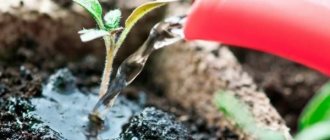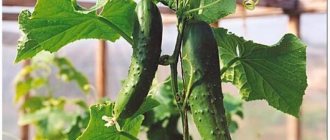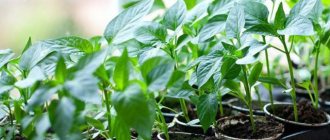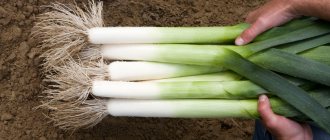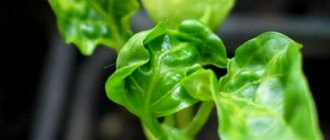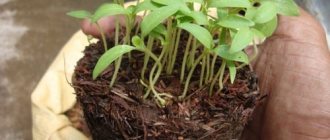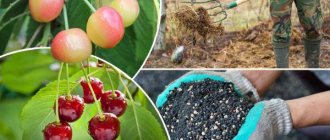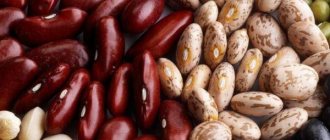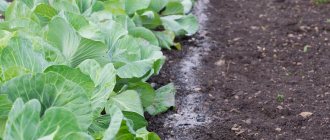Secrets of proper cultivation, planting, fertilizing and planting eggplant seedlings in the ground.
Eggplant is a plant that requires temperature and humidity. Improper organization of conditions for the growth of eggplant seedlings can lead to illness and even death. At the same time, following simple recommendations will allow you to get a good harvest from strong, healthy plants.
Eggplant seedlings
Preparing eggplant seeds for sowing as seedlings: soaking in potassium permanganate
Preparing eggplant seeds for sowing is no different from preparing seeds of other vegetable crops and consists of several stages:
- Visually inspect eggplant seeds and discard empty, small, damaged and black ones.
- Place the remaining good seeds in a solution of table salt (1 teaspoon of salt per 1 cup of water), mix gently and leave for 10 - 15 minutes.
- Discard seeds that float to the surface of the water - they are not suitable for planting.
- Remove the seeds that have sunk to the bottom from the saline solution and spread them out to dry.
- Treat the seeds with a solution of potassium permanganate (0.3 - 0.5 g of potassium permanganate per 0.5 cup of water).
- To protect the roots of future seedlings from rot, and the leaves and stems from fusarium wilt, treat the seeds with Trichodermin or Fitosporin.
- Soak clean cosmetic cotton pads generously and place them on a large flat plate.
- Place eggplant seeds on discs.
- Cover each seed disk with .
- Place the plate with the discs in a plastic container or plastic bag and put it in a warm place until germination (5 - 7 days).
Potassium permanganate solution for soaking eggplant seeds
IMPORTANT: The soaking step is optional. Eggplant seeds can be planted in the ground immediately after disinfection treatment. You can also skip soaking in an antifungal solution. However, soaking the seeds in a solution of potassium permanganate for two hours must be done in any case.
Before soaking or planting in the ground, seeds can be placed in a growth stimulator ( Kornevin, Etamon, Zircon, Epin ) for several hours.
Experienced gardeners warm up the seeds before planting , which improves the quality of seedlings and increases their resistance to diseases and pests. Warming up is carried out for 3 - 5 minutes in the oven at a temperature of 50˚C or in a thermos with water at the same temperature.
Seed preparation
It is believed that pre-planting seed preparation is not necessary. However, a certain set of manipulations at an early stage of cultivation makes it possible to select viable, viable seeds and protect future eggplants from infection by pests and the development of diseases.
Pathogenic bacteria and pest larvae can be destroyed from the surface of the seed using a concentrated manganese solution or special chemicals. So, the seeds should be immersed in a glass and filled with a disinfectant solution for 30 minutes. After the allotted time has passed, the water must be drained and the seeds must be thoroughly rinsed with running water.
At the stage of preparation for sowing, it is also recommended to soak the seeds in a nutrient solution. This measure accelerates their germination and makes future seedlings stronger and more productive. For such soaking, you can use a solution of nitrophoska: 1 tsp per 1 liter of water. substances. Ready-made mineral mixtures for these purposes are also available for sale. Soak the seeds in the nutrient solution for 24 hours. After processing, the seeds are not washed.
Germinating seeds allows you to select viable specimens and speed up the process of growing eggplants. To do this, place the eggplant seeds in a damp piece of cotton cloth or gauze. Wet material, with seeds wrapped inside, can be placed on a saucer or placed in a plastic bag. At the germination stage, you should carefully monitor the moisture level of the tissue and temperature conditions. At a temperature of +25-+300C, eggplant seeds germinate in 9-10 days.
Preparing the soil and sowing eggplant seeds for seedlings
To plant eggplant seeds, you should take clean, loose soil with neutral acidity . Before seeds are planted in the soil, it must be disinfected. To do this, the soil is kept over boiling water steam for about 30 - 40 minutes or thoroughly poured with boiling water.
Preparing the soil for planting eggplant seeds
IMPORTANT: You can start planting seeds only when the soil has completely cooled after disinfection treatment.
If you plan to pick eggplant seedlings, special seedling boxes are used to plant the seeds.
If the plants grow without picking, use peat cups or cassettes with sections (10*10 cm), in which the root system of each plant will be formed individually.
IMPORTANT: Growing eggplant seedlings without picking gives the best results.
In boxes so that the distance between adjacent seeds is about 2 cm, and between rows - 6 cm. The planting depth should be within 1.5 - 2 cm.
Seeds are sown at the same depth using the non-pick growing method. Place 2 – 3 seeds in each glass.
Holes must be made in advance in cups and drawers to prevent water stagnation.
Peat cups for growing eggplant seedlings without picking
IMPORTANT: Before planting seeds, the soil in pots and boxes must be sufficiently moistened.
After the seeds are planted, the containers are covered with glass or wrapped in polyethylene and placed in a warm room until germination.
IMPORTANT: While waiting for germination, sharp fluctuations in air temperature are unacceptable.
Containers with planted seeds are covered with polyethylene
Stage one: selection of seeds and sowing dates
Fruit ripening requires a fairly long period of time, which, depending on the variety, reaches 95-150 days from the moment of germination. The culture is heat-loving, and the domestic climate spoils us with blessed summer days for no more than three months (and in some places even less). Therefore, in order for plants to grow stronger, bloom and bear fruit within the time allotted by our nature, they must be grown through seedlings.
The most popular among gardeners are proven eggplant varieties:
- Helios. The growing season is from 95 to 120 days, the fruits are round or oval. The bush is tall – 70-100 cm.
- Black handsome. The growing season is from 105 to 150 days, the variety is resistant to most diseases. The plant is not very spreading, 60-70 cm tall.
- Iceberg. Reaches technical maturity in 115-125 days. The fruits are white, pear-shaped. The bush is spreading, up to 60 cm in height.
- Globe. The growing season is from 100 to 115 days, the variety is resistant to most diseases. The fruits are quite large, round in shape, light in color, with a soft cream or pinkish tint.
To grow healthy, strong, but not overgrown seedlings, it is necessary to correctly calculate the timing of sowing seeds. This is not difficult to do. You need to start from the climatic conditions of your region and determine the time when the threat of return spring frosts has passed. In some places it may be the end of April, but in others you need to wait until the end of May. 55 - 60 days before this, you can sow eggplant seeds.
The land for sowing is prepared so that it is moderately fertile and loose. A mixture of humus and peat in a 2:1 ratio is best. To improve the moisture and breathability of the soil, add sawdust scalded with boiling water or a little coarse river sand if the mixture turns out to be clayey. Also, in order to prevent fungal diseases and to enrich the soil with microelements, you can add a little wood ash.
Advice! The eggplant root system is very sensitive to transplants, after which it suffers for a long time and is delayed in development. Growing seedlings in peat pots or separate containers helps prevent this, which makes it possible to plant plants using transfer methods, along with a clod of earth.
After sowing the seeds, the containers are covered with glass or transparent film. This creates a special microclimate with constant temperature and humidity.
How often to water eggplant seedlings on a windowsill, in a greenhouse, or in open ground?
The first moistening of the soil in pots and boxes is carried out 3 days after planting the seeds . Then they wait for germination.
IMPORTANT: To water eggplant seedlings, use melted water or water that has been standing for at least 24 hours, the temperature of which is in the range of 28 - 31˚C.
When the cotyledon leaves of young plants unfold, you need to organize regular watering ( once every 5 days ). In order not to wash away the tender eggplant shoots with a stream of water, watering is carried out from a watering can with a nozzle or from a sprayer. It is advisable to water the plants in the first half of the day.
IMPORTANT: You need to water the eggplant seedlings so that the soil is neither too dry nor too wet. If the soil is still quite moist after the last watering, you should not overwater the plants, as this may lead to rotting of the root system.
Watering eggplant seedlings
Difficult time: picking
Eggplants have very fragile roots that are easily damaged . Plants can hardly tolerate picking; at this moment they need to be handled especially carefully.
The procedure is carried out early, immediately after the first pair of true leaves unfold. 1-2 days before moving, seedlings are watered abundantly . If this is not done, dry lumps of earth may break off the roots during transplantation.
The plants are carefully lifted with a sharp peg and transferred to a new pot along with a small lump of earth. The seedling is placed in the prepared hole and carefully watered along the stem . This procedure will help the roots straighten out and the plant will quickly adapt to its new location.
After picking, young eggplants are not watered for 4-5 days . During this time, the roots will get stronger and begin to actively draw moisture from the soil.
You need to moisten the seedlings using a spray bottle or a fine-mesh watering can, once every 6-7 days. The soil should dry out between waterings.
The procedure should be carried out only in warm weather, avoiding moisture on the leaves. It is important to shade the seedlings from direct sunlight; it is better to water them early in the morning or after sunset . The same regime is recommended for adult plants.
After the first watering, you need to feed the seedlings once a week with liquid complex fertilizer . After feeding the plants, it is recommended to water them with warm water.
Grown seedlings require more liquid than newly emerged sprouts. There is no need to spray the seedlings; drops remaining on the leaves can cause burns in bright sunlight.
Eggplants do not tolerate stagnant moisture in the soil . To avoid this, drainage holes are made in the bottom of the pots, after which the containers are placed on a tray. Any water that appears in the pan must be drained. A thin layer of wood ash scattered over the surface of the soil will help save eggplants when they become waterlogged.
How to treat eggplant seedlings with hydrogen peroxide against pests and diseases?
Hydrogen peroxide can be used instead of potassium permanganate solution to disinfect eggplant seeds. To do this, it is enough to soak the seeds selected for cultivation in a 10% peroxide solution.
If you soak the seeds in a 0.4% hydrogen peroxide solution and leave for 10–12 hours, the product will act as a growth stimulator. Seeds that have undergone this treatment are not afraid of disease. They will sprout quickly, the seedlings will develop more intensively, and the yield of the bushes will be slightly higher than the yield from untreated plants.
IMPORTANT: After treatment with hydrogen peroxide, the seeds must be washed and dried.
Preventive spraying with a solution of hydrogen peroxide will protect adult eggplant plants from fungal diseases. Dilute 1 tbsp in a bucket of water. peroxide 10% and carry out the treatment.
Hydrogen peroxide will protect eggplant seedlings from pests
Yeast fertilizer for eggplant seedlings: recipe
Conventional baker's yeast is microorganisms, single-celled fungi. Once in well-warmed soil, they release several essential substances for eggplant seedlings. respond to the simultaneous supply of vitamin B, thiamine, auxins and cytokinins with good growth and ovary, rapid development of a powerful healthy root system, and subsequently a rich harvest.
To prepare yeast nutrition for eggplant seedlings, you will need:
- yeast
- sugar
- water
Recipe No. 1 using dry yeast:
- Fill a liter jar with warm water
- Add dry yeast (1 g) to water
- Add sugar (1 tsp)
- Mix thoroughly and leave for 2 – 4 hours
- Before use, dilute with water in a ratio of 1:5
- Water the plants
Recipe #2 using live yeast:
- Fill a quart jar with water, leaving room for the yeast.
- Add live yeast (50 g)
- Stir and leave for 2 – 4 hours
- Before use, dilute with water in a ratio of 1:5
IMPORTANT: Yeast supplements will not work if the water or soil is cool. If you pour a yeast solution over eggplant seedlings in cold soil, the feeding will have no effect.
After using yeast solutions, ash or crushed egg shells must be added to the soil in the bed with eggplant seedlings.
Yeast fertilizer for eggplant seedlings
Watering during flowering
During flowering of eggplants, the water regime is combined with the fertilizer application regime. Organic and mineral additives are used for feeding. For watering during this period, the following rules and sequence of actions are observed:
- water only with warm water;
- use only distilled water without chlorine;
- feed along with watering;
- mandatory mulching after moisture absorption.
Watering the seedlings is carried out directly at the root. A drip irrigation system is the ideal solution to the problem. The water temperature should be 23-25°C. If the water is colder, the plant will lose color. Nutrients are added immediately after all the moisture has been absorbed, right under the root. If drip irrigation is used, fertilizers are added to the water to water the soil.
Mulching and loosening is carried out weekly, in the evening, to avoid drying out of the soil.
There is a unique method that preserves soil moisture. It involves loosening the soil to a depth of 5 cm, 11-12 hours after watering.
Feeding eggplant seedlings with iodine: breeding recipe
Iodine is an excellent antiseptic that can prevent the development of putrefactive diseases on eggplant seedlings.
Eggplant plants are sprayed with iodine solution shortly before flowering. This treatment will give strength to the plants and protect them from rot. To prepare the solution, dissolve 10 drops of iodine in 10 liters of water. In this case, the water temperature should be 22 - 24˚С.
Also, seedlings are watered with water and iodine immediately after planting in the ground at the rate of 1 liter of iodine solution per 1 eggplant bush.
Preparation of iodine solution for feeding eggplant seedlings
Stage four: harvesting
https://www.youtube.com/watch?v=aNBjyBxdxrI
This is perhaps the most pleasant and long-awaited stage of the work. Eggplants ripen gradually and the first fruits can be tasted by July. When harvesting, you must use pruning shears, this way you will save your hands from prickly thorns and damage the plant.
Determining the ripeness of a vegetable is quite simple. You need to press on it with your finger - the dent formed should quickly recover. If there is no dent left, it means the fruit is not yet ripe, and if it remains on the vegetable, it is already overripe.
As you can see, sowing eggplants, growing and caring for them do not require special knowledge. If tomatoes are successfully ripening on your plot or you are doing an excellent job growing sweet peppers, then you can also get your own harvest. To begin with, it is enough to purchase a couple of early ripening varieties, and with experience you can grow others. Over time, your harvest will consist of large purple vegetables, pear-shaped fruits with a lilac hue, white round or even striped varieties. I wish you successful endeavors and good harvests!
Banana peel fertilizer for eggplant seedlings: recipe
Banana peel is a source of potassium and calcium , the content of which in the soil is necessary for the normal growth and development of eggplant seedlings. Also, fertilizer made from banana skins can effectively combat some insect pests that cannot tolerate potassium-saturated soil.
Banana peels for making fertilizer
There are several options for preparing fertilizer from banana skins for eggplant seedlings:
Recipe No. 1. Universal compost from banana skins . Prepare compost in the fall.
- Mix finely chopped banana skins with soil in a 2:1 ratio.
- Place in a thick black plastic bag.
- Make holes in the bag and leave it for the winter.
- In the spring, the compost can be used for its intended purpose, and to help it thaw as quickly as possible, the bag can be temporarily placed in a greenhouse or heated barn.
Recipe No. 2. Dried skins. You can dry banana skins on a hot radiator or in the oven. They are then crushed and stored in an airtight container. Use this fertilizer at the bottom of containers with eggplant seedlings, as mold may appear on the surface of the soil.
Recipe No. 3. Burying banana skins in the ground . Finely chopped banana skins are buried in close proximity to eggplant seedlings in need of feeding. Within a week the plants will look healthy.
Recipe No. 4. Infusion of banana skins for greenhouse eggplant seedlings.
- Place the skins from 4 bananas in a three-liter jar and fill with water.
- Leave in a dark place for 3 days.
- Dilute the resulting liquid with water (1:1).
- Use for watering plants in a greenhouse at the rate of 1 liter of infusion per 1 m2 of bed.
Infusion of banana skins for greenhouse eggplant seedlings
Seedling care
In general, caring for eggplant seedlings is the same as for all nightshade crops.
Lighting and temperature
Young eggplant seedlings are very demanding in terms of light. For normal growth and development, they need 12 hours of daylight.
Useful tips for lighting seedlings:
- if there is not enough light, or the day is too short, turn on the lamps - LED or fluorescent;
- Place containers with seedlings in the brightest place;
- periodically turn the glasses with seedlings so that they do not lean to one side;
- If the weather is cloudy, do not turn off the lights during the day.
Eggplants are heat-loving and temperature-sensitive. Recommended temperatures:
- before emergence – from +25 to +28°C;
- immediately after emergence – from +16 to +18°C;
- a few days after germination – from +20 to +24°C.
Watering
Eggplant seedlings require watering. It is important to maintain a balance, not over-wetting the soil, but also not allowing it to dry out. The rate and frequency of watering depend on how quickly the moisture evaporates and the size of the seedlings - the older the plants, the more water they need.
Rules for watering eggplant seedlings:
- for irrigation use only warm (+23…+25°C) and settled water;
- The best time for watering is early morning or evening;
- Water only at the roots.
Top dressing
Feeding of seedlings begins when 2 or 4 true leaves appear - if pickless cultivation is used. If the seedlings have picked, then you need to wait - fertilizing is carried out 10 days after transplantation.
Feeding rules:
- The first time, seedlings are fed with a highly diluted solution to prevent burns to the roots.
- For fertilizing, it is convenient to use complex fertilizers - “Agricola”, “Fertiku Lux”, “Athlete” and others.
- If the seedlings are planted in a purchased substrate, then fertilizing is not necessary - it contains everything necessary to feed the seedlings throughout the entire growing season.
- You can feed the seedlings with a mixture you prepare yourself. For the first feeding, dissolve in 1 liter of water:
- potassium – 1 g;
- wood ash – 1 tsp;
- saltpeter – 0.5 tsp;
- superphosphate – 4 g.
- For the second feeding, organic fertilizer is used. It is applied 10 days after the first feeding. How to feed seedlings with organic matter:
- mix chicken manure – fermented or in granules – with water in a ratio of 1:15;
- leave the droppings for 2-3 days and water the seedlings.
- A week before planting seedlings in the ground, fertilize the seedlings with superphosphate. For 5 liters of mixture take:
- superphosphate – 35 g;
- potassium salt – 15 g.
- Instead of mineral and organic fertilizers, you can add “Potassium Humate”. This fertilizer increases the stress resistance of plants and enhances root growth.
Living space
Eggplant seedlings at all stages of cultivation require a certain amount of space to grow.
Methods for providing living space:
- picking - seedlings are planted so that they do not interfere with each other;
- moving the glasses with seedlings apart - as the seedlings grow, the intervals between containers increase.
Prevention of seedling diseases
Most diseases that affect eggplant seedlings can be cured, but it is much more effective to prevent their occurrence.
Prevention measures:
- Collect seeds only from healthy bushes. Disinfect them before planting in a saturated solution of potassium permanganate for 30 minutes.
- During the growing period, water the seedlings 2-3 times with a 0.5% solution of potassium permanganate. The interval between treatments is 3 weeks.
- Spray the seedlings with milk diluted in water (1:10). After spraying, cover the plants with film to prevent the transmission of viral infection.
- During the growing season, apply 2-3 foliar feedings with solutions containing microelements.
- Disinfect containers for seedlings, tools and equipment with a 5% solution of potassium permanganate.
How to water eggplant seedlings so that they grow better and are strong: folk remedies
It is impossible to get a good eggplant harvest without taking care of good feeding of the seedlings on time. The standard feeding scheme consists of three stages and can be carried out either with the help of chemical fertilizers or by adding organic substances to the soil according to folk recipes.
For the first time , young plants are fed during the formation of cotyledon leaves. For feeding, use any complex fertilizer with a high nitrogen content. You can use an infusion of manure (1:10), chicken droppings (1:20) or an infusion of weeds (1:5).
Manure infusion for eggplant seedlings
IMPORTANT: It must be taken into account that birds have a unique metabolism, so different portions of droppings from the same bird may contain different amounts of nutrients. It is very easy to “burn” the roots of the seedlings by not observing the proportions when diluting the litter.
The second feeding is carried out if the eggplant seedlings are picked . 10-14 days after picking, mineral fertilizers are applied to promote the development of a healthy root system. At home, you can make fertilizer from eggshells. For this you will need:
- eggshells (half a three-liter jar)
- melt water
- Preparation:
- Fill the shell with water
- Leave for 3 days in a warm place
- Drain the water and fill with new
- Leave for three days
- Drain the water and refill with new water
- Drain the water, remove the shells from the jar and dry
- Grind or crush the shell
- Sprinkle the resulting powder onto the beds (3 tbsp per 1 m2)
Eggshells for preparing fertilizer
6 - 7 days before planting in open ground , it is best to treat eggplant seedlings with a purchased Ecogel (consumption 1 liter per 100 liters of water). This is a biological preparation containing organic acids, chitosan and silver ions. Ecogel stimulates root development, disinfects and builds immunity to various diseases.
IMPORTANT: Ecogel is safe for people, animals and insects.
Possible problems with eggplant seedlings and ways to solve them
On the way to growing eggplant seedlings, a gardener may encounter a number of problems that he should know about in advance. This will allow you to help the plant in a timely and correct manner.
The seedlings stopped developing after the dive
This is normal. Within 7-10 days, the eggplant bushes will get used to the new conditions and then continue to develop.
To stimulate root formation, watering with the addition of the preparations “Kornevin” or “Epin” is recommended. To ensure that eggplant seedlings spend the entire time they are growing at home on developing the root system and increasing green mass, it is recommended to sow the seeds in individual containers.
The seedlings are withering
Often, seeing the withered leaves of his green pets, the gardener thinks that he missed the watering time - and this would not be a problem - you just need to saturate the seedlings with moisture. Another thing is when the leaves droop when the soil is moist - this is a sign of root rot. The plant requires immediate transplantation into new disinfected soil and watering in small doses.
Blackleg
Frequent waterlogging of the soil in the seedling container affects the young plant at the base of the stem. It darkens, becomes thinner and cracks. It is impossible to save the damaged sprout, but you can protect neighboring plants from infection.
It is necessary to identify sprouts with signs of disease and remove them. Cover the soil under the remaining crops with wood ash - it will draw off excess water. And spray the sprouts themselves with a solution of the Previkur preparation. (2ml/1l water.)
Hypothermia of the root system
This often happens if the seedling boxes are on a cold windowsill, and there is a large temperature difference between the above-ground part and the root system.
The leaf plates continue to evaporate moisture, and the “cold” roots cannot cope with their functions, as a result of which the seedlings look depressed and sick.
It is enough to place an insulating substrate under the boxes or raise them slightly above the level of the window sill, and the balance will be restored.
Seedling leaves turn yellow
If this happens to cotyledon leaves, then this is quite normal and does not pose a danger. If the foliage turns yellow along the entire stem, this indicates a lack of microelements.
It is recommended to feed eggplant seedlings every 2 weeks, alternating organic fertilizers with mineral ones.
Yellow spots on leaves
Damage of this nature can be a consequence of sunburn and does not cause any particular harm, other than the ethical appearance of the plant.
But this could also be a sign of potassium deficiency. In this case, drying begins from the edges, covering an increasingly larger area of the leaf plate.
Watering with potassium-containing fertilizers or ash solution (1 tbsp/1 l of water) will help.
Mechanical damage to leaves
If recesses, holes or eaten edges appear on the leaves of eggplants, then there is no doubt that pests have worked here. Whiteflies, sciarids, aphids and spider mites pose a danger to eggplant seedlings.
At the first signs, the leaves are carefully examined and washed with a solution of laundry or green soap. Then spray with Fitoverma solution.
Pollinating the soil in seedling pots with ground red pepper powder also repels midges well and is absolutely harmless to plants.
Lighting for eggplant seedlings at home
Eggplant seedlings need intense lighting with a daylight duration of 10 - 12 hours .
IMPORTANT: If you do not provide the seedlings with the necessary lighting, they will stretch, the stems and leaves will lose strength and color, the plants will get sick and will have a hard time with picking and planting in the ground.
fluorescent lamps are installed above the boxes with eggplant seedlings . The optimal height for their attachment is 50–60 cm from the seedlings .
Lighting for eggplant seedlings at home
Picking and hardening eggplant seedlings
Experienced vegetable growers often try to plant eggplant seedlings in such a way as to eliminate the stage of their picking. This is explained by the fact that the weak roots of eggplants become seriously ill after transplantation, and the plants themselves, which survive the dive, are severely retarded in growth.
Indeed, planting eggplant seeds initially in separate pots is preferable. However, if it is not possible to sow the crop in this way, and diving cannot be avoided, then you need to try to do it in such a way as not to harm the weak roots of the seedlings.
IMPORTANT: Diving is carried out when the second large leaves appear on the seedlings. This usually occurs from 20 to 30 days from the moment of sowing. If you dive earlier, the young plants will most likely die, if later, they will be sick for a long time in the new place.
Proceed as follows for planting eggplant seedlings::
- A few hours before diving, water the seedlings .
- Prepare cups with a diameter of about 10 cm.
- Fill the cups with soil mixture.
- Water the soil in cups with a nutrient solution (mullein -130 g, urea - 0.5 tbsp, ash - 0.5 tsp per 5 liters of water).
- Using a pencil, make a small hole in the center of each cup .
- carefully remove the plant from the common box using a spatula
- Visually assess the length of the root , pinch off the root after 0.5 cm.
- Deepen the plant and fill the voids with soil.
Picked eggplant seedlings
Hardening off eggplant seedlings is carried out 14 - 18 days before the expected date of planting them in open ground. As soon as the temperature outside is established and exceeds 15˚C, the boxes with seedlings are placed outside daily for 2 to 3 hours.
If the air temperature is significantly lower, seedlings cannot be removed. Reducing watering and thoroughly ventilating the room will be sufficient.
IMPORTANT: Hardened eggplant seedlings take root more easily in the soil and calmly respond to changes in air temperature and weather changes.
Hardening off seedlings
Diseases and pests of seedlings
In order to promptly identify that plants need treatment for a particular disease or pest, you need to be able to identify them.
Diseases
There are many ailments to which eggplant seedlings can be exposed. The most common of them include black leg, mosaic, and bacterial spotting. Proper care and timely protection are the key to plant health. If a problem does arise, you need to take urgent measures aimed at treatment.
Blackleg
Blackleg, which also has another name - root collar rot, affects not only young seedlings, but also adult plantings. The reasons for its occurrence are too wet soil, which leads to rotting of the roots, low temperature, dense plantings, and insufficient lighting. The disease should be combated by spraying with a solution of drugs such as Trichodermin, Planriz, Fitolavin, Farmayod, Fitosporin-M. Treatment with Hom and Previkur is also carried out.
Black leg occurs due to excessive soil moisture
Powdery mildew
With this disease, which is caused by fungi, first the lower leaves are affected, then the stem, which leads to wilting and death of the plant. The appearance of the disease can be judged by a white coating. Seedlings are more susceptible to disease in greenhouse conditions. To combat, you should use the drugs Pentafag-S, Fitosporin-M. In addition, spraying is carried out using such products as Quadris, Tiovit, Cumulus, Privent (0.1%).
Powdery mildew is easily recognized by the white coating on the leaves
Late blight
Like other nightshades, eggplant is susceptible to late blight. When plants are infected, brown spots appear on the leaves, after which the foliage dries out. To avoid infection, first of all, you should give preference to varieties that are resistant to the disease, and also observe crop rotation on the site, i.e. do not plant eggplant in places and near them where crops of the nightshade family were previously grown (potatoes, tomatoes, pepper).
Various means can help in the fight against the disease. You can start with folk ones, for which they use garlic infusion (1 tbsp. chopped garlic per 3 liters of water, leave for a week, dilute 1:1 with water before processing). In addition, you can use Bordeaux mixture or a solution of copper sulfate (0.2%), which is sprayed on the plants. You can also use biological products: Fitosporin-M, Alirin, Gamair, Baksis. For a complex of diseases, fungicides such as Quadris, Ridomil, Thanos are suitable.
Brown late blight spots spread quickly, leaves dry out
Tracheomycosis wilt
Fungi cause plant wilting. Pathogens are transmitted by seed material. First, the root system is affected, then the leaves, after which the plant dies. You should fight with Fitosporin-M, Fitolavin, Farmayod, Gamair.
If it is not possible to stop tracheomycosis wilt at the beginning of development, all plants will have to be destroyed
Mosaic of leaves
The disease occurs as a result of damage to leaves by the mottled or tobacco mosaic virus. The virus multiplies in the soil and is spread by pests such as spider mites and aphids. To combat, they resort to spraying with Farmayod, Fitosporin M, and also feed with Uniflor-micro (2 tsp per 10 liters of water).
The spots resemble a mosaic, and the leaves seem variegated
Gray rot
Temperature fluctuations and waterlogging contribute to the occurrence of the disease. The causative agent is a fungus. Treatment is carried out by drying the soil and watering with the same preparations as for mosaic. Plants are also treated with Horus and Antracol.
White or gray moss on the stem is the first sign of rot disease
Pests
In addition to diseases, pests can cause significant damage to the future harvest, which indicates the need to conduct daily inspection of plants to identify and neutralize parasites.
Aphid
The first sign of a pest is curled leaves. You can fight it with an infusion of garlic (chop 2 heads, add 1 liter of water and leave for 5 days, dilute 1:1 with water before spraying) or onion peels (100 g of peel, pour 5 liters of water and leave for 5 days). You can treat plants with biological preparations Actofit, Fitoverm, Entobacterin, Strela. Tanrek, Biotlin. If the listed remedies do not help, then use Intavir, Karate, Iskra, Kinmiks.
You can detect aphids by looking under the leaves of plants and noticing that they have begun to curl.
Whitefly
The harm caused is not only the sucking of juice from plants, but also the release of substances that create a favorable environment for the development of fungi. The pest loves high temperatures and dry air, so it is important to maintain optimal conditions when growing eggplant seedlings. The fight consists of treating with garlic infusion or the drugs Actellik, Permethrin, Malathion, Aktara, Neudosan.
Whitefly infects plants in indoor and greenhouse conditions
Spider mite
The presence of a pest on plants can be judged by the withering and falling of leaves, and the appearance of black dots on the reverse side. To get rid of mites, treat with infusion of garlic and onion peels. As a last resort, they resort to spraying with the preparations Actellik, Fitoverm, Actofit, Apollo, Akarin, Vermitek, Fufanon.
It is sometimes possible to detect spider mites only when most of the plant is affected.
When and how to plant eggplant seedlings in a greenhouse?
If the greenhouse is not heated, eggplant seedlings are planted at a steady air temperature of 16 - 18˚C.
IMPORTANT: Eggplants are planted in a greenhouse separately from other plants. If this is not possible, proximity to tomato seedlings is acceptable.
Eggplant plants are planted in such a way that there is a distance of 40 - 50 cm between them, and 50 cm between adjacent rows. Do not deepen the plants too much. The recesses should be 1.5 - 2.5 cm above the clod of earth.
Before planting seedlings, the soil in the greenhouse can be prepared as follows (consumption rates per 1 per 1 m2 of soil):
- add ash (2 tbsp.)
- superphosphate (1 tbsp)
- ammonium nitrate (1 - 1.5 tbsp.)
- potassium sulfate (1.5 tbsp)
- peat (0.5 buckets)
- river sand (0.5 buckets)
- dig up the ground and level its surface
- prepare the wells
- pour 1 - 1.5 liters of water into each hole
When the holes are prepared, plants are carefully planted in them and the voids are sprinkled with soil. If seedlings are placed in holes in peat pots, it is necessary to cut off their bottoms and tear one wall to help the roots break through as quickly as possible.
IMPORTANT: If the eggplant seedlings are very weak or overgrown, it is better to tie them up.
Greenhouse for growing eggplant seedlings
Sowing
Fill the prepared containers with the mixture and moisten it.
I once read advice in an old magazine: moisten the soil for seedlings with melt water. The author gave the following arguments in favor of this method: melt water has a perfectly regular crystal lattice, short-term exposure to cold stimulates the growth and vitality of plants, making them less susceptible to diseases. We don’t always have snow at the time of sowing, but if possible, I use it to moisten the soil. We moisten the soil with melted snow water. Photo by the author And you know, this really works: “snow” seedlings are much stronger and hardier, and can withstand transplantation more easily than those that I water with rainwater.
Important : snow can only be used with ungerminated seeds; if sprouts have already appeared, the soil should be warmed to +25...+28°C before planting.
Let's return to the sowing process.
There is 1 seed in 1 cell. Photo by the author
I put 1 seed in each cell (on a slightly compacted bed), sprinkle it on top with 0.5 cm of soil, which I also moisten. Then I cover it with film and put it in a warm place. Until the seeds have sprouted, they do not need light and oxygen, the main thing is that it be warm. The ideal temperature during this period is considered to be +25…+28°C.
Important : do not sow different varieties in one cassette - their germination times can vary greatly, and a situation is possible when seedlings of one variety have already sprouted, they need to be freed from the film and the temperature lowered, while the seeds of another are still in the process of germination - what to do then? It is better to sow in several containers - each variety separately.
What temperature can eggplant seedlings withstand?
Eggplant seedlings feel best at +22˚C. When the temperature drops, plants get sick, their growth and development slow down.
If seedlings are planted in the ground and the air temperature drops to 1 - 3˚C, the seedlings will die. To prevent this from happening, when planting eggplants in a greenhouse early, it is necessary to equip it with a stove in case of an unexpected cold snap.
The optimal temperature for eggplant seedlings is +22˚С
Growing eggplant seedlings on toilet paper without soil
The technology for growing eggplant seedlings without soil on toilet paper is very simple, and this method allows the gardener to save time and space:
- Cut dense polyethylene into strips of arbitrary length, 10 cm wide.
- Place a strip of toilet paper on top of each strip of cellophane.
- Wet the paper generously with water.
- Scatter the eggplant seeds, leaving some space around the edges.
- Cover the top of the seeds with another strip of paper.
- Wet the top strip.
- Cover with plastic.
- Roll everything up.
- Insert the roll into a cut bottle or glass.
- Pour 3 – 5 cm of water (depending on the diameter of the glass).
- Leave it on the windowsill, changing and adding water to the glass from time to time.
just 7 days, the first shoots will appear from under the layers of film, and by the end of the second week all the plants will sprout. Transplant plants into the greenhouse when they have two true leaves .
Growing eggplant seedlings on toilet paper without soil
Planting eggplant seedlings in open ground
Eggplant seedlings are planted in open ground when at least 5, but no more than 7 leaves appear on the plants . In this case, the height of the seedlings will be 8–10 cm.
IMPORTANT: A prerequisite for planting eggplants in open ground is an air temperature of +22˚С.
Soil preparation and technology for planting seedlings in open ground are similar to planting in a greenhouse.
Growing eggplant seedlings on toilet paper without soil
A good eggplant harvest will be a reward for a patient, attentive vegetable grower. Within 30–40 days from the start of flowering, the first fruits will appear on the bushes. The most important thing is to collect them in time, without allowing them to fully ripen, and to provide the best conditions for preservation: mix with ash and place in a cool, dark place.
Hardening
2-3 weeks before planting eggplant seedlings in the ground, it is necessary to begin hardening the young plants. When the outside temperature exceeds +150C and there is no strong wind, pots with plants can be taken outside.
Advice! At the initial stages of hardening, eggplants should remain outside for no more than half an hour.
Subsequently, this period is gradually increased until full daylight hours.
Hardening is especially important for eggplants that will be planted in open ground. This procedure allows plants to gradually adapt to the temperature and humidity characteristics of the atmosphere and exposure to direct sunlight.
Important! Hardening of eggplant seedlings can be done by opening window frames, as well as by taking the plants out onto the balcony. However, it is worth remembering that a draft is detrimental to culture.


